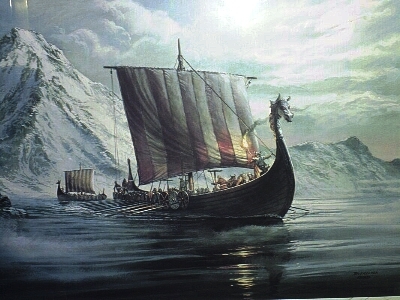A squadron of Viking warships passes by a rugged coastline on its way to raid European settlements.
A factor in the growing strength and versatility of Scandinavian civilization was the emergence of more martial, or aggressive and warlike, elements of society. In this the Scandinavians got their cue, in a sense, from what was happening with their distant cousins, the Germanic tribes living in the lands north of the Alps and south of Denmark. Prolonged trade and cultural contact with Rome had steadily enriched the Germans in all manner of goods, from gold to textiles to weapons. In the 300s and 400s small bands of Scandinavians began raiding the Germanic lands to acquire some of this loot.
Small trading centers were built to facilitate exchanges of goods among these chiefdoms, some of which would, centuries later, become the medieval nations of Denmark, Sweden, and Norway. These centers increasingly became personal power bases for strong, enterprising warrior-chiefs who wanted to get rich and make names for themselves at the same time. Some evidence shows that, in Hall’s words, “The evergrowing political power of Scandinavian kings encouraged chieftains to bolster their waning status in the homeland by seeking the large and instant rewards that could be gained in lucrative overseas ventures.”
Thus, steady increases in population, increased trade, the growth of forceful military cliques, and the rise of small kingdoms all contributed to the development of an economically and militarily stronger and more robust Scandinavian society. It was perhaps inevitable that some sectors of this society would eventually seek to expand their opportunities by venturing beyond their homelands. And their excellent command of ships and seafaring, which had developed over the preceding centuries, made this expansion both possible and enticing.
The overall result was the sudden burst of Viking raids that began at Lindisfarne in 793. These early attacks, lasting from the 790s to about 834, had several factors in common. First, they were relatively small—usually consisting of ten or twelve ships at most. Second, the raiders almost always confined their nefarious activities to the coasts of the lands they plundered, at first consisting mainly of Britain, Ireland, Francia (France), and Frisia (northwestern Germany). Also, the incursions were nearly always brief and of a hit-and-run nature.
This approach was designed to frustrate local military forces, which usually had no idea where the attacks would occur and were therefore unable to rush to the rescue in time.
In addition, a large percentage of the targets were churches and monasteries, and not only because these places possessed accumulated wealth. The early Vikings may have been uncultured, but they were often quite canny and clever in political and military matters. A number of modern experts suggest, as one of them puts it, that:
this was a deliberate targeting of the sites which provided the religious and ideological underpinning of west European Christianity. [It was] an attempt, in otherwords, of a form of psychological warfare, with the aims of undermining the west European belief system and showing that the Christians’ god was not omnipotent but vulnerable, and not superior to the gods of Scandinavia.
Finally, most of the early Viking raids occurred in the warmer months, when seafaring was easier and safer, and the ships returned to Scandinavia in the winter. This gave the residents of coastal northeastern Europe a welcome breather from the ongoing and frightening Norse threat. In time, however, such respites became a thing of the past. Anew phase of the Viking menace was about to begin, one in which sporadic raiding would be replaced by major attempts at conquest and settlement. Some Vikings were no longer content simply with tiny pieces of the European pie. Much to the horror of the inhabitants of inland areas who thought they were relatively safe, the part-time attackers became full-time invaders.
